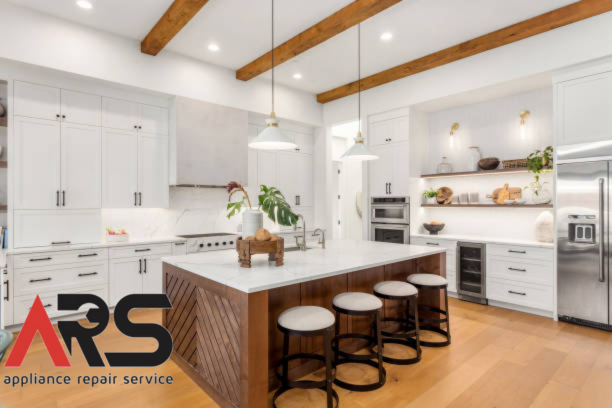
Spring
Tuesday morning brings the promise of Easter and the gentle reminder that spring has finally arrived. At ARS Appliance Repair Services, we greet this change in seasons with enthusiasm, knowing that it marks not just a shift in weather, but also a time when households may encounter various appliance challenges. As the leading appliance repair company in Toronto, covering the entire GTA, Ottawa, and much of southern Ontario, we recognize the importance of proactive maintenance, especially during seasonal transitions
Today’s blog aims to bring you the knowledge and skills needed to address common spring appliance issues. From refrigerators to air conditioners, washers to ovens, we’ll guide you through troubleshooting steps designed to keep your appliances running smoothly and your home functioning seamlessly. So, as spring unfolds its beauty outside, let’s ensure your indoor environment remains equally delightful by tackling those appliance challenges head-on.
Join us as we talk about spring appliance care, providing practical solutions and expert advice to help you navigate any issues that may arise. Let’s embrace the start of spring with reliable appliance care and a home that functions flawlessly throughout spring and beyond.
Refrigerator Cooling Problems
As temperatures rise with spring, your refrigerator becomes even more vital in preserving your food’s freshness. However, if you’ve noticed your refrigerator struggling to maintain the chill or experiencing temperature fluctuations, it could indicate underlying cooling issues. Fear not! In this comprehensive guide, we’ll walk you through the common symptoms of refrigerator cooling problems and provide practical troubleshooting steps to ensure your refrigerator stays cool and your food stays fresh throughout the season.
Symptoms:
- Warm refrigerator despite correct temperature settings
- Fluctuating temperatures inside the fridge
Troubleshooting steps:
- Check temperature settings:
- Ensure the thermostat is set to the appropriate temperature for the refrigerator section.
- Adjust settings if necessary to achieve optimal cooling.
- Clean condenser coils:
- Unplug the refrigerator and locate the condenser coils, typically located at the back or underneath the unit.
- Use a vacuum cleaner or a brush to remove dust, dirt, and debris from the coils.
- Clean coils improve heat dissipation, enhancing the refrigerator’s cooling efficiency.
- Inspect door seals for leaks:
- Check the integrity of the door seals by visually inspecting them for cracks, tears, or gaps.
- Close the refrigerator door on a piece of paper and try to pull it out. If it slips out easily, the seals may need replacement.
- Damaged seals can lead to air leaks, causing the refrigerator to work harder to maintain cool temperatures.
- Ensure proper ventilation:
- Position the refrigerator at least a few inches away from the wall to allow for adequate airflow.
- Check for obstructions around vents or grilles and clear any blockages.
- Good ventilation prevents overheating and ensures efficient operation of the refrigerator’s cooling system.
Washer Leaks and Drainage Issues
When it comes to diagnosing washer leaks and drainage issues, being able to recognize the symptoms is the first step towards resolving the problem efficiently. Here’s what to look out for:
Symptoms:
- Puddles of water form around the washer after each cycle.
- Difficulty draining water from the machine, leading to standing water in the drum.
- Unusual noises during the drain cycle, indicate potential blockages or malfunctions.
Troubleshooting steps:
- Inspect hoses for leaks or kinks:
- Check the inlet and outlet hoses for any signs of damage, such as cracks or bulges.
- Ensure the hoses are properly connected and free from obstructions.
- Replace any damaged hoses to prevent leaks.
- Clean the lint trap and drain pump:
- Locate the lint trap near the bottom of the washer and remove any accumulated lint or debris.
- Access the drain pump and remove any foreign objects, such as coins or hair ties, that may be causing blockages.
- Regularly cleaning these components helps maintain proper drainage and prevents clogs.
- Check for overloaded loads:
- Avoid overloading the washer with too many clothes, as this can strain the drainage system.
- Follow the manufacturer’s guidelines for load capacity to ensure optimal performance.
- If necessary, divide large loads into smaller ones to prevent strain on the washer.
- Ensure the washer is level:
- Use a bubble level to check if the washer is sitting evenly on the floor.
- Adjust the leveling feet as needed to stabilize the machine and prevent water from pooling.
Air Conditioner Malfunctions
In the spring temperatures begin to rise, and your air conditioner becomes essential for maintaining indoor comfort. However, if you notice signs of malfunction, addressing them promptly is crucial. In this guide, we’ll explore common symptoms of air conditioning issues and provide practical troubleshooting steps. Let’s tackle these challenges head-on to ensure your home stays cool and comfortable throughout the season.
Symptoms:
- Inadequate cooling despite running the air conditioner
- Unusual noises or vibrations coming from the unit
Troubleshooting steps:
- Change or clean the air filter:
- Locate the air filter, usually positioned in the air handler or return air grille.
- Remove the filter and inspect it for dirt, dust, or debris buildup.
- Clean or replace the filter if it appears dirty or clogged to improve airflow and cooling efficiency.
- Clear debris from the outdoor unit:
- Turn off the power to the air conditioner at the main electrical panel.
- Remove any leaves, grass clippings, or other debris obstructing the outdoor unit.
- Use a vacuum cleaner or hose to gently clean the condenser coils and fan blades.
- Verify thermostat settings:
- Check the thermostat settings to ensure they are correctly set for cooling mode.
- Lower the temperature setting to see if it triggers the air conditioner to start cooling.
- If the thermostat is programmable, confirm the schedule and settings are configured correctly.
- Inspect ductwork for leaks or blockages:
- Examine the ductwork for any visible signs of damage, such as holes, gaps, or disconnected sections.
- Use duct tape or mastic sealant to seal any leaks found in the ductwork.
- Ensure that vents and registers are not blocked by furniture, curtains, or other obstructions.
Oven and Stove Problems
When it comes to cooking, your oven and stove are essential tools in your kitchen arsenal. However, encountering issues with these appliances can throw a wrench into your meal preparations. In this section, we’ll delve into common symptoms of oven and stove problems and provide straightforward troubleshooting steps to get your kitchen back up and running smoothly. Let’s roll up our sleeves and tackle these issues head-on.
Symptoms:
- Uneven cooking or baking results
- Inconsistent temperatures in the oven
- Burners not lighting or heating properly
Troubleshooting steps:
- Calibrate the oven temperature:
- Use an oven thermometer to check the actual temperature inside the oven.
- If the temperature is off, recalibrate the oven according to the manufacturer’s instructions.
- This ensures accurate cooking and baking results.
- Clean the oven and stove burners:
- Remove any food debris or grease buildup from the oven interior, stove burners, and burner caps.
- Use a non-abrasive cleaner and a brush or sponge to scrub away stubborn residue.
- Clean burners ensure proper ignition and heat distribution.
- Check gas supply for stoves:
- If you have a gas stove, ensure the gas supply is turned on and there are no leaks in the gas line.
- Test the igniter by listening for the clicking sound when turning on the burner.
- If the burner fails to ignite, check for obstructions in the burner ports or a faulty igniter.
- Test the heating elements for continuity:
- For electric ovens and stoves, use a multimeter to test the continuity of the heating elements.
- Disconnect the power supply and remove the heating elements from the oven or stove.
- Test each element for continuity by placing the multimeter probes on each end of the element.
- A reading of infinite resistance indicates a faulty heating element that needs replacement.
Dishwasher Performance Issues
Your dishwasher stands as a reliable companion in the kitchen, ensuring your dishes emerge sparkling clean after each meal. Yet, encountering performance issues can disrupt this harmony. In this segment, we’ll unravel the mysteries behind common dishwasher problems and arm you with straightforward solutions. Let’s dive in and restore your dishwasher’s efficiency, ensuring pristine dishes with every cycle.
Symptoms:
- Dishes coming out of the dishwasher are still dirty or soapy
- Water not draining properly from the dishwasher after a cycle
Troubleshooting steps:
- Clean the dishwasher filter and spray arms:
- Locate the dishwasher filter and remove any food particles or debris trapped inside.
- Inspect the spray arms for clogs or blockages and clean them thoroughly.
- Clean filter and spray arms ensure proper water circulation for effective cleaning.
- Verify proper loading technique:
- Ensure dishes are loaded properly, avoiding overcrowding and blocking the spray arms.
- Place dishes at an angle to allow water to reach all surfaces for thorough cleaning.
- Proper loading prevents detergent and food residue buildup on dishes.
- Check for clogs in the drain hose:
- Disconnect the dishwasher from power and access the drain hose, usually located under the sink.
- Remove any clogs or debris obstructing the drain hose using a plumbing snake or wire hanger.
- Clearing the drain hose allows for proper drainage of water after each cycle.
- Run a vinegar rinse cycle:
- Pour white vinegar into a dishwasher-safe container and place it on the top rack of the dishwasher.
- Run a hot water cycle with the vinegar to dissolve mineral deposits and remove buildup from the dishwasher interior.
- Vinegar rinse cycles help improve dishwasher performance and eliminate lingering odors.
Ensuring Springtime Appliance Harmony
As we navigate the transition into spring, ensuring the smooth operation of our household appliances is paramount. From refrigerators to dishwashers, each appliance plays a vital role in maintaining our daily routines. By addressing common springtime issues promptly and effectively, we can enjoy uninterrupted comfort and convenience throughout the season.
Remember, regular maintenance and timely troubleshooting can prevent minor problems from escalating into major headaches. Whether it’s cleaning condenser coils or unclogging drain hoses, taking proactive steps now can save you time, money, and frustration down the road.
At ARS Appliances Repair Services, we’re committed to keeping your appliances running smoothly year-round. If you encounter any challenges beyond what these troubleshooting guides cover, don’t hesitate to reach out to our expert team for assistance. With our expertise and dedication to service, we’ll ensure your appliances are ready to tackle whatever spring throws their way.
Here’s to a season of seamless appliance performance and a home filled with comfort and convenience. Happy spring from all of us at ARS Appliances Repair Services!

ARS Appliance Repair Service has been trusted across Toronto, Ottawa, and Southern Ontario for over a decade. Our licensed, manufacturer-authorized technicians specialize in repairing all major household and commercial appliances with genuine parts and warranty-backed service. From refrigerators and washers to ovens, dishwashers, and more, we restore appliances quickly, professionally, and correctly the first time, earning the confidence of homeowners and businesses throughout the region.





